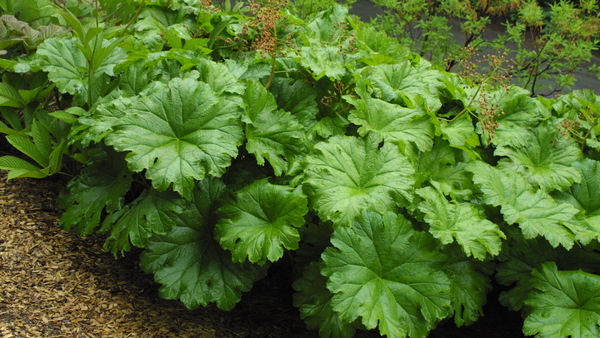
The relatively adaptable and easygoing North American native plants in Great Natives From the Western United States—That Anyone Can Grow are excellent alternatives to commonly grown nonnative plants. These picks are as good—or even better—than the old standbys. Here’s how they compare.
Instead of: Meadow rue |
Try: ‘Denver Gold’ columbine |
‘Denver Gold’ has beautifully textured foliage like meadow rue (Thalictrum spp. and cvs., Zones 5–9) and European columbine (Aquilegia vulgaris, Zones 3–9), but it blooms much longer and is more adaptable.
Instead of: Ajuga |
Try: Sandia alumroot |
If you are looking for an attractive edging plant, Sandia alumroot is less likely to invade the lawn than ajuga (Ajuga reptans, Zones 3–10) or many spreading sedums (Sedum spp. and cvs., Zones 4–9).
Instead of: Russian sage |
Try: Pink butterfly mint |
Pink butterfly mint is drought tolerant and adaptable to most well-drained soils, like Russian sage (Salvia yangii, Zones 5–9), but without its invasive tendencies. Or try it as an easier-to-grow substitute for lavender (Lavandula spp. and cvs., Zones 5–8).
Instead of: Eurasian sedums |
Try: Old man’s bones |
Old man’s bones tolerates shade and is a noninvasive alternative to Eurasian sedums such as moss stonecrop (Sedum acre, Zones 4–9) and stringy stonecrop (S. sarmentosum, Zones 4–9).
Instead of: ‘Karl Foerster’ feather reed grass |
Try: Undaunted® ruby muhly grass |
Hardier than most muhlies, Undaunted® makes a sophisticated replacement for overused ‘Karl Foerster’ (Calamagrostis × acutiflora ‘Karl Foerster’, Zones 5–9).
Instead of: Spanish bluebell |
Try: Giant camas |
This Northwestern beauty is less invasive than Spanish bluebell (Hyacinthoides hispanica, Zones 3–8) and certain ornamental onions (Allium cvs.), which can become ineradicable garden pests.
Instead of: Calamint |
Try: ‘Marian Sampson’ scarlet horsemint |
With cultural needs similar to those of garden mints like calamint (Calamintha nepeta, Zones 5–7) and savories (Satureja spp. and cvs., Zones 6–8), ‘Marian Sampson’ is showier and has a much longer bloom time.
Instead of: Catmint |
Try: Pineleaf penstemon |
Pineleaf penstemon’s unique color makes it an instant garden attraction. It can be used in the same way as catmints (Nepeta spp. and cvs., Zones 3–9), but it is more restrained.
Instead of: Eurasian salvias |
Try: Mojave sage |
Mojave sage is much more tolerant of heat and drought than commonly grown Eurasian salvias such as woodland sage (Salvia nemorosa, Zones 4–8) and meadow sage (S. pratensis, Zones 4–8).
Instead of: Spirea |
Try: Fernbush |
Fernbush is an extremely tough customer, is more restrained than spireas (Spiraea spp. and cvs., Zones 3–9) or forsythias (Forsythia spp. and cvs., Zones 3–9), and has good midsummer color.
Instead of: Mugo pine |
Try: Dwarf pinyon pine |
Perfect for very sunny exposures with excellent drainage, dwarf pinyon pine is more restrained and drought tolerant than mugo pine (Pinus mugo, Zones 2–7).
Instead of: Yarrow |
Try: Kannah Creek® buckwheat |
Yarrows (Achillea spp. and cvs., Zones 3–8) and some spurges (Euphorbia spp. and cvs., Zones 3–10) can be weedy, seedy garden thugs. Kannah Creek® buckwheat provides carefree color without becoming invasive.
More on native plants:
Great Native Plants from the West–That Anyone Can Grow
Best Native Plants for Each Region of the United States
Panayoti Kelaidis is senior curator and director of outreach at Denver Botanic Gardens.
Fine Gardening Recommended Products

A.M. Leonard Deluxe Soil Knife & Leather Sheath Combo
Fine Gardening receives a commission for items purchased through links on this site, including Amazon Associates and other affiliate advertising programs.


















Comments
Interesting that you gave the botanical names for the plants you suggested replacing, but only the common names for the suggested native plants.
Log in or create an account to post a comment.
Sign up Log in